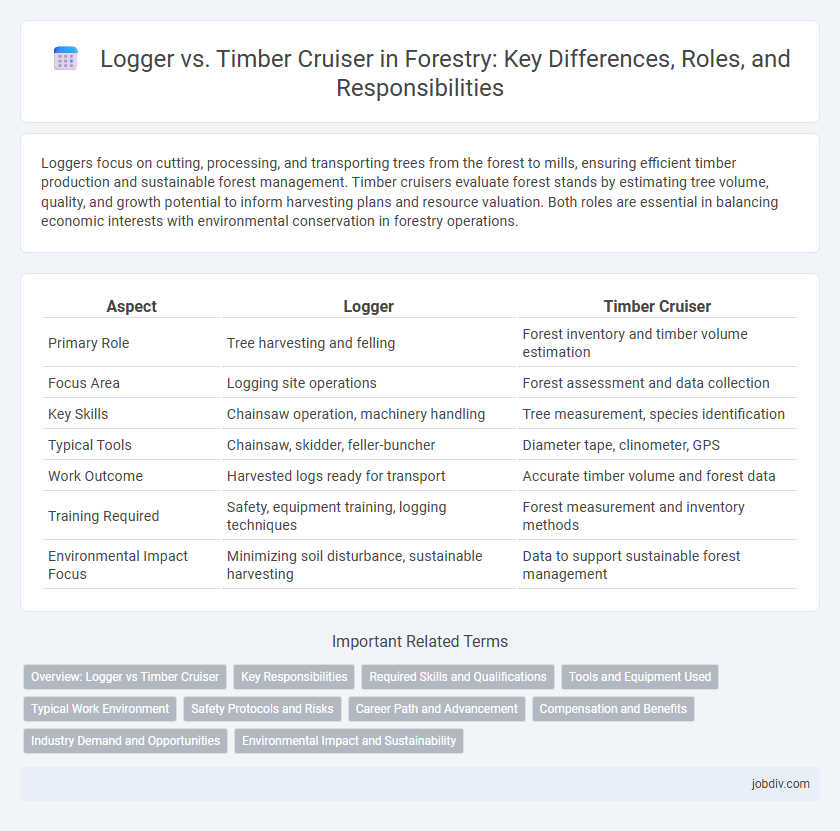Loggers focus on cutting, processing, and transporting trees from the forest to mills, ensuring efficient timber production and sustainable forest management. Timber cruisers evaluate forest stands by estimating tree volume, quality, and growth potential to inform harvesting plans and resource valuation. Both roles are essential in balancing economic interests with environmental conservation in forestry operations.
Table of Comparison
| Aspect | Logger | Timber Cruiser |
|---|---|---|
| Primary Role | Tree harvesting and felling | Forest inventory and timber volume estimation |
| Focus Area | Logging site operations | Forest assessment and data collection |
| Key Skills | Chainsaw operation, machinery handling | Tree measurement, species identification |
| Typical Tools | Chainsaw, skidder, feller-buncher | Diameter tape, clinometer, GPS |
| Work Outcome | Harvested logs ready for transport | Accurate timber volume and forest data |
| Training Required | Safety, equipment training, logging techniques | Forest measurement and inventory methods |
| Environmental Impact Focus | Minimizing soil disturbance, sustainable harvesting | Data to support sustainable forest management |
Overview: Logger vs Timber Cruiser
Loggers focus on the physical process of cutting, processing, and transporting timber from forests to mills, playing a crucial role in the timber supply chain. Timber cruisers specialize in forest inventory and assessment, estimating timber volume, species composition, and stand conditions to inform sustainable harvesting plans. Both roles are vital in forestry operations, with loggers handling extraction and timber cruisers ensuring accurate resource management.
Key Responsibilities
Loggers are responsible for the physical harvesting of trees, including cutting, skidding, and transporting timber to mills or processing sites. Timber cruisers specialize in assessing forest stands by measuring tree volume, species composition, and growth rates to inform sustainable harvesting plans. Both roles are essential in managing forest resources efficiently and ensuring accurate inventory data for forestry operations.
Required Skills and Qualifications
Loggers require physical strength, knowledge of chainsaw operation, and understanding of safety protocols to effectively harvest timber in variable forest conditions. Timber cruisers must possess skills in forest measurement, map reading, and data analysis to accurately estimate timber volume and assess forest resources. Both roles demand familiarity with environmental regulations and the ability to work outdoors for extended periods.
Tools and Equipment Used
Loggers primarily use chainsaws, skidders, and harvesters to fell, process, and transport trees efficiently in forest operations. Timber cruisers rely on tools such as laser rangefinders, diameter tapes, clinometers, and GPS devices to measure tree dimensions, assess forest stand conditions, and map timber resources for inventory and planning. The distinct equipment reflects their roles: loggers focus on timber extraction, while timber cruisers specialize in accurate forest measurement and data collection.
Typical Work Environment
Loggers typically work outdoors in rugged forest terrains, operating heavy machinery and handling timber harvesting directly on-site, often facing variable weather conditions and physically demanding tasks. Timber cruisers conduct field assessments in forest areas, measuring tree volume and stand density to estimate timber value, requiring extensive knowledge of forest ecology and navigation through dense woods. Both professions spend significant time in remote, natural environments but differ in their specific operational focus and physical activity levels.
Safety Protocols and Risks
Loggers face high-risk environments involving heavy machinery and falling trees, demanding strict adherence to safety protocols such as wearing personal protective equipment and maintaining clear communication. Timber cruisers, while exposed to fewer immediate physical hazards, must still follow safety guidelines related to terrain navigation and wildlife encounters. Both roles require comprehensive training in hazard identification and emergency response to minimize occupational injuries in forestry operations.
Career Path and Advancement
Loggers typically start their careers in physically demanding roles involving tree felling and machinery operation, progressing to supervisory or equipment specialist positions through hands-on experience and certification. Timber Cruisers follow a more technical career path, requiring skills in forest measurement, mapping, and data analysis, often advancing into forestry management or consulting roles. Both careers offer advancement opportunities but differ in focus, with loggers emphasizing operational expertise and timber cruisers prioritizing analytical and management skills.
Compensation and Benefits
Loggers typically receive hourly wages or piece-rate pay, with compensation often influenced by the volume and type of timber harvested, while timber cruisers earn salaries or contractual fees based on the acreage surveyed and data collected. Loggers may benefit from performance bonuses and overtime pay due to physically demanding and hazardous work, whereas timber cruisers enjoy more stable income and comprehensive benefits, including health insurance and retirement plans. Both roles may have seasonal employment patterns, but timber cruisers generally have greater job security and access to professional development incentives.
Industry Demand and Opportunities
Logger positions are essential for the hands-on harvesting of timber, meeting the high demand for skilled laborers in active logging operations driven by increasing construction and paper industries. Timber cruisers provide critical services in forest inventory assessment and land appraisal, creating opportunities in sustainable forest management and timber sales that support long-term industry planning. Both roles are crucial, but timber cruisers often see growing demand in areas emphasizing certified forest practices and resource conservation.
Environmental Impact and Sustainability
Loggers directly impact forest ecosystems through tree harvesting methods, which can lead to soil compaction and habitat disruption if not managed sustainably. Timber cruisers assess forest stands and help develop sustainable management plans by estimating tree volume and growth, promoting selective logging practices. Combining precise timber cruising with responsible logging reduces ecological footprints and supports long-term forest regeneration.
Logger vs Timber Cruiser Infographic

 jobdiv.com
jobdiv.com